
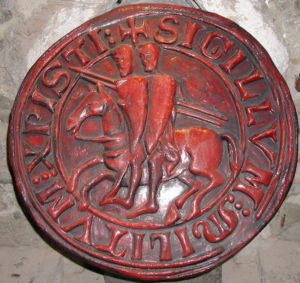
Templar Seal
I am a modern day priestess involved in the pursuit of light, life, love and liberty and I have always found myself linked inexplicably to many ancient religious paths. The Ancient brotherhood of the Templars had a past that intrigued me with a sense that they had something to impart to me. My ancient historical interests had taken me to many places of Holy worship around the world. They had begun in Ancient Egypt with its arid plateaus and river valleys of hidden secrets. Then later the Ancient Celtic, Roman and Greek worlds became my study. All have provided a richness so vast in their mythologies and Gods, that I have been occupied with their cultures and theologies for many years. In each of these places I visited and with every book I had read on each subject, I placed myself in-setu as a person of the times, soaking up the etheric energies to get a sense or feel for how it must have been like to be alive in those times. I could picture myself among the pillars at the Temple of Diana, feel the mud below my feet along the Nile, be kneeling in prayer at a sacred well in Crete giving thanks, or dancing in the wild woods of Summer in the Bavarian Alps, because I had been to all of these places and had received a sense of discovery and understanding.
The closest thing I had ever had anything to do with the Crusades were the costuming of the Renaissance Fairs of Southern California, and even that was off by several hundred years. I had been to France twice before, but my interests of those experiences lay in the early prehistoric migrations or later in the 15th through 18th Centuries with the romanticism of Shakespeare. I had read about the Crusades. I knew that they were a combination of the Church wanting to destroy those that had non-believers and a State wanting more property. It was already a militaristic society with a penchant for vengeance and greed. Then something hit home. Was this fight still not going on? After all, there exists still today many countries with people who are still fighting a “liberation theology.”
In order for me to become clear about what I was embarking upon, it was necessary for me to investigate the history of the Knights Templar more deeply. To perhaps look at what prompted the creation of the Templar brotherhood. What I discovered was a series of events that politically and religiously set the stage for the perfect fervor that was to come.
There was a “miraculous” discovery by Empress Helena, wife of Constantine, 298 years after the death of Christ, of the Holy sepulcher. It was here that Solomon had erected a house where the Lord had appeared unto David. Where it was thought the remains of the true cross lay. A church was immediately erected over this sacred monument. When word got out, the pilgrims began to flood in. The Arabians captured the city in 637, and gave the Christians protection and the right to their own worship. In 1065 the Arabians were defeated by a Northern savage tribe, the Turcomans, who did not honor the Christian beliefs. In fact, they ridiculed, oppressed, plundered, imprisoned, ransomed and massacred most of the Christian citizens and pilgrims. In Addison’s book, The History of the Knights Templars, he says, “a nerve was touched of exquisite feeling, and the sensation vibrated to the heart of Europe.” The threat of having holy articles at such a holy place put in jeopardy was a compelling reason for an army to be dispatched; for at that time they believed that relics were imbued with supernatural power. Here then was the spark that stirred Pope Urban II to launch the First Crusade in November of 1095.
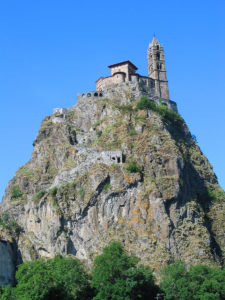
Chapelle Saint-Michel D’Aiguilhe
I pictured many a knight coming here for blessing. When the sun broke through a small and deep-set window above, it flooded the high altar and floor before it. In that sudden burst of light, I felt an exquisite feeling of pure devotional love, a strengthened will powered by a strong determination, a courage that seemed to come from the very sturdiness of the rock below our knees, as those first crusaders must have felt.
The first Crusade was successful, partially. At least the Turcomans were sent out of Jerusalem, but they took up strongholds in the rest of Palestine. The pilgrims thought all was safe, but they were continually subjected to plunder, robbery, hostility and death along the roads that lead to Jerusalem. Then I learned how the Templars came to be, who were originally known as the Poor Fellow-soldiers of Jesus Christ.
The Knights Templar had began with nine French knights in 1118, who had “petitioned the king of Jerusalem, King Baldwin II, to allow them to live in a wing of the palace next to the ancient Temple of Solomon,” within the sacred enclosure of the Temple on Mount Moriah. It was once thought that they did this in order to explore most closely the secrets and possible treasures in the caverns below the Temple. Most importantly, they planned to protect all pilgrims on their way to and from this Holy City. Two of its members were well known, Hugh de Payens and Geoffrey de St. Aldemar; and it was Hugh de Payens, who was eventually chosen as the first Master of the Temple. Ten years later, after having kept their promise, they were granted the Pope’s approval. Because they militantly protected this temple, they came next to be known as the “Knighthood of the Temple of Solomon.”
In 1128, St. Bernard asked for a convocation of an ecclesiastical council at Troyes, where the Rule, or the regulation of the fraternity was written. It was divided into seventy-two chapters and was addressed, “to all who disdain to follow after their own wills, and desire with purity of mind to fight for the most high and true king.” It was most thorough, being many pages long listing their proper conduct. There were devotional exercises, self-mortification, periodic fasting, prayer and constant church attendance. “That being refreshed and satisfied with heavenly food …of the divine mysteries …that none might be afraid of the fight, but be prepared for the crown.”
The ranks of the Order grew with each nobleman donating portions of his properties and revenues. King Steven of England contributed a property in Essex. In 1133, King Alfonso of Aragon and Navarre, willed his entire kingdom to the Templars. When the sanction of the first priests that were allowed to spill blood was accepted, many joined the order. Like the feudal distinctions that separated the people of Europe, the knights were a combination of many classes. There were educated men that controlled the banking, but then there were many illiterate and simple men that filled the ranks. The Templars grew, and so did their holdings. Thus the Templars became the servants and companions of royalty. Princes, nobles, illustrious persons, sovereigns and their subjects all gave handsome amounts. All of which were to go to protecting the Holy city of Jerusalem. The Count of Champagne, the tenth member to join, and Abbot Bernard de Clairvaux utilized some of the money and properties collected to have built the cathedral at Chartres.
There were other Orders of Knights existing at the same time: The Knights Hospitallers or the Knights of St. John and the Teutonic Knights of St. Mary. At one time and another, they all fought along side each other in different skirmishes during the many waves of the first crusade upon the Holy City.
Hugh de Payens, having firmly established holdings in France, Spain and England, returned to Jerusalem with newly elected Templars from principally, France and England. This was done none too soon, for while away the Mussulmen and warlike Zinghis who felt themselves to be the chosen champions to avenge their prophet competent in their zeal, over-threw the Crusaders. Cries for support went to the Pope, and the second Crusade was begun. Pope Eugenius then decreed that the Templars would wear a red cross on a white tunic over their left breast so that on a battlefield every Christian would know them immediately as an ally. They were then called the Red Friars and the Red Cross Knights.
Brother Everard des Barres became the new Master of the Temple upon the death of Hugh de Payens, and with the standard of Louis the French king, they went back to Palestine. Conrad, emperor of Germany was already there. Together they all fought in the city of Damascus against the forces of Nur-ad-Din, the sultan of Egypt. They fought a bitter battle in Antioch, where the Turcomans and the armies of Nur-ad-din destroyed what was left and recaptured Jerusalem. Instead of rousing more Templars to their aid, Master Barres abdicated his authority and entered a monastery in Clairvaux unable to accept the blood upon his hands. The new Master would not give up, Bernard de Tremelay. He mounted an attack on the prime city of Ascalon and through a breach in the walls made it into the center of the town, where severely, every Templar was slain. Tremelay was succeeded by Brother Bertrand de Blanquefort, and he too, after attempting to march on the great city of Tiberias, was surrounded and three hundred brethren were slain. Himself and eighty-seven men were taken captive. The second crusade had been a failure. The stern fanaticism and religious zeal of the Nur-ad-Din armies, like the Templars, were just stronger. In that, the Templars and Muslims were remarkably similar. Both fought for their God with the belief that the other was the infidel and that the fight for their religion was in obedience to their God.
With these thoughts of the second crusade and the down-hearted majority of Templars returning to Europe with only a small foothold left in Gaza in Palestine, we entered the small church in La Couvertoirade, the ancient fortified town that was once the property of the Knights Templars and a last stronghold. All of the Templars were not knights; there were also priests and serving brethren who returned desiring a more protected and monastic life. Many fortified towns such as La Courvertoirade were built and many commandaries such as at St. Eulalie de Cernon and La Cavalrie were established.
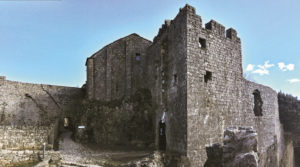
La Courvertoirade
Next to it is the church of Saint Christopher, built in the 13th Century. It was built upon an older church, the Saint Christol parish church of the 12th Century. its base having been carved from a quadrangle of hewn-out rock. Just inside its doors two small steles on the far wall gave evidence that this was once a Templar place of prayer. Sparsely furnished, without even pews, a rough gray stone floor and walls with a leaking nave, all gave the ancient feeling that a returned pilgrim might walk in the door at any time. In the ceiling at the junction of the small crenelations to the wall, were Templar crosses. Alone and caught in a distant memory, I leaned against one wall and closed my eyes. I felt an overwhelming sense of hardship and disappointment. I pictured the sad faces of some returned pilgrims coming in through the light of the church door. Maybe they had gone all the way to the Holy land just to find that upon arrival, they had to turn right around, escaping with their life and had never been able to pray at the holy mount. Perhaps they had lost too many brothers on the battlefield. Perhaps they had returned home to find that all too much time had passed and their loved ones were gone.
Just outside, there is a small cemetery with half a dozen Templar tombstones. These are shaped from rock into a keyhole design. True to the Templar symbolism, their tops were round and inside were the crosses, or fleur-de-lis. No names, no dates, just circles and crosses. It was gray and lightly sprinkling, but it only added to the total ambiance of this amazingly intact village. Surrounding all are ramparts with high walls and a parapet, which can be walked upon half of the way around that gave visage to the bright green Larzac plain spread out below.
I remembered that at the end of the second crusade, even though the Templar virtues were exulted and their privileges confirmed, there arose alleged complaints of monetary and land abuse by some of the clergy. Many priest and Templar supporters had stayed in France and England to enjoy these land holdings, consuming large proportions of those revenues, which ought to have been faithfully forwarded to the Holy Land. There came about a collision with the jealous ecclesiastics. It was said that the Templars took over churches without consent, “that they administered the sacraments to excommunicated persons and buried them with all the usual ceremonies of the church.” They had also enjoyed immunities and advantages without legitimate right. They were not obliged to pay tithes to the church, but they could receive them. No brother could be excommunicated, and where ever they went they were to be received with reverence and ceremony. It was not to last.
The Pope, still concerned about the retrieval of their holdings in Jerusalem put out a call for more crusades in 1157, 1165, 1166, 1169, 1173, 1181 and 1184, but each time it fell on deaf ears. At this time a religious sect hiding in Tripoli descending from the Ismaelians of Persia, known as the Hassissin or assassins, became known. The Count of Tripoli, a large monetary supporter of the Templars, was slain by these fanatics. The Templars flew to arms, found the assassin stronghold and demanded compensation in the form of an annual tribute. The Hassissin leader told the leaders in Jerusalem that if his people embraced Christianity, could they be released from the payment? It was agreed, but one Knight, Templar Walter du Mesnil, killed the envoy, which caused the King of Jerusalem to become incensed and demanded that the guilty party be turned over to him. Master of the Knights, St. Amand, responded that they did not answer to anyone but the Pope. However, later, Mesnil was delivered in chains.
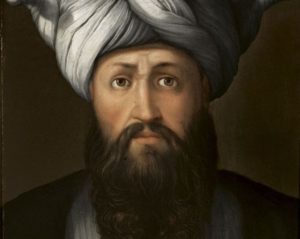
Saladin
During this time, the Templar strongholds in England had become more numerous and a New Temple was erected for the military monks, novices, Superiors and for the now retiring elder Templars that had actually survived the first crusades. This Temple in London came to be known as the “storehouse of treasure.” An inquisition and a recounting of the Templar possessions and holdings was demanded by King Henry. There were holdings in Jerusalem, Tripoli, Sicily, Castille, Leon and Aragon. There were also numerous holdings in Germany, Hungary and Greece. France and England held the greatest riches and real estate. It was estimated that in the early 1200’s that the annual income of the order was six million sterling!
I bore witness to the wealth of the churches that were built in France in several places that I visited. One was as I stood near the transept of the great cathedral of Notre-Dame in Paris. On the site of a Roman temple the building was commissioned in 1159 by the Bishop de Sully. The Kings gallery features 28 stone images of the kings of Judah. All though it is difficult to know which is part of the original building since during the Revolution the building was desecrated, standing between the West rose window and the South rose window, I sensed a greatness that the church must have felt. The Holy Land was still secured. The brilliance of the reds and blues showed unknowingly an allegory to the spiritual pureness of the Holy endeavor and the ruby red blood spilled in the name of glory. The Templar heroes of the time were venerated at each Mass. In the low hum of the tourists, I thought I heard the murmuring of tens of thousands praying for their safety.
In Chartres Cathedral, on a previous trip, I remembered being in the Apsidal Chapel, standing before the Veil of the Virgin relic. The original Romanesque Cathedral was built in 1020. Later the Cathedral was mostly destroyed by fire in 1194, though the statue of the Virgin has survived. I saw this golden Virgin shrine haloed in brilliant white lights. They sparkled like diamonds around her, exulting her perpetuation. I remember experiencing a sense of awe wash over me. It had become more than a statue, more than adoration or a tribute; it represented the proliferation of a glorified idealism for religious perfection.
In Paris again, the ethereal and magical church of Sainte-Chapelle had given much of the same feeling. It originally housed Christ’s Crown of Thorns and fragments of the true cross that had been purchased from the Emperor of Constantinople. Built in 1248, Louis the IX had this masterpiece created with 15 magnificent stained-glass windows depicting more than 1,000 biblical scenes from Genesis through to the Apocalypse. Here we sat first on one side looking up at the North windows and then on the other side looking up at the South windows. I was tremendously impressed by the ardor of the artists that had rigorously recreated the insubstantial biblical stories in such detail. The depiction’s though glorious they were when the light poured through, were not what impressed me, but the degree of fervored belief that had cast its own strength.
Though the wealth and strength of the Templars had grown, only two groups of knights were expedited from Europe to Palestine to reinforce the holding of the Holy Mount. In 1185 a conference was held between the sovereigns of France and England concerning the proposed succor to the Holy Land. Word of their disenchantment reached the Jerusalem Christians. Other problems were brewing too. The Patriarch Heraclius of the Temple church quarreled with the king of England. He was already suspected of poisoning the archbishop of Tyre. But the coup de gras was soon to come. The Grand master Gerard de Riderfort, had crowned the nephew of king Baldwin the IV, when he died. But Baldwin the V also died only seven months later.
The Grand Master then raised Sibylla, the mother of the deceased and her husband Guy of Lusignan to the throne. Guy de Lusignan was not favored by the court; not even by his own brother Geoffrey. A great dissension arose. The Count of Tripoli withdrew in disgust, and “the state was torn by faction at a time when all the energies of the population were required to defend the country from the Moslems.”
Saladin lay in waiting for the perfect time. He’d assembled an army outside of Damascus and although the Templars with support of the Hospitallars and the new count of Tripoli’s forces had greatly strengthened their fortresses, most perished in those bloody battles. Master Amand was taken prisoner and after a refusal for a trade release of Saladin’s nephew, he was thrown to prison and there died. Saladin’s secretary wrote, “I bear witness that there is no God but that one great God who hath no partner, that Mohammed is his servant and apostle, who hath opened unto us the gates of the right road to salvation.” How perfectly the Islamic faithful were guided by the exact same sense of declaration as the Pope had enumerated to the Templar Christians to hold Jerusalem. The tipping of the karmic scale had begun to shift. On May 10, 1187 one of Saladin’s sons crossed the Jordan with 7,000 men for the first major assault. The Master of that cities temple tried to rally as many knights as fast as he could, but the inevitable slaughter commenced. The Muslim fighters severed the heads of the Templars and attached them to their lances, as they headed for the next battle at Tiberias.
Later in July, the Templars lead an attack against Saladin’s 80,000 who were backed by the lake of Tiberias. The Templars rushed “like lions upon the Moslem infidels.” Saladin set fire to the dry grasses between them and the wind blew the smoke directly into the faces of the on rushing knights. This battle has been compared to the last judgment, by the dust, smoke and fire, din and blood. Saladin’s secretary concluded, “The avenging sword of the true believers was drawn forth against the infidels; the faith of the Unity was opposed to the faith of the Trinity, and speedy ruin, desolation, and destruction, overtook the miserable sons of baptism!” After the conquest of almost forty cities, Saladin’s men rushed the holy city, Jerusalem; and on October 2, took control of the sacred city. Saladin had the Crusader army decapitated and washed the entire Temple area down with rose water. The ancient Temple was restored to its original condition with Muslim sanctity. Most all Templar holdings were ravaged, burned or captured except for Ascalan, Gaza, and Tyre. Two of those cities surrendered, but Tyre was left standing. Saladins attentions were distracted by the Turcomans beginning an invasion into the north of Syria. A truce was called for a period of four years, in which time the Templars desperately sought regrouping and support from king Henry the II of England.
Templars from all surrounding nations rallied and made many valid attempts to roust Saladin. In the mean time, the third crusade was being planned. Philip Augustus and Richard Coeur de Lion arrived in Acre on the shores of Palestine with royal fleets, ready to force their hand. They recaptured many of the forts and cities and settled into Gaza before the final blow. Their strength in laying siege was rewarded and thereby was ratified “a treaty whereby the Christians were to enjoy the privilege of visiting Jerusalem as pilgrims.” Tyre, Acre and Jaffa were yielded to the Christians. The Templars back in control strengthened their dominion.
It was not for long, however, because the Carizmians, a fierce tribe of Tartars from north Asia overthrew and slew nearly 1,000 men. Surprisingly, since the Carizmians were also the enemies of the Muslim sultan, they joined forces and routed their now shared enemy. This temporary alliance was not what Frederick the Second, wanted. In fact he accused the Templars of making war upon the sultan of Egypt in defiance of their present treaty. Fearing reprisal, another crusade was called. Despite this warning, in 1249 the Templars with the aid of French king, Louis IX went off to Egypt where they took the city of Damietta in retalience of their captives that had been taken to Cairo in the earlier war with Saladin.
Edward Prince of Wales, son of Henry the Second, king of England, rallied to the aid of the last defenders in Jerusalem and came with a fleet to Acre. He defeated the infidels and pushed them back to Egypt. On his journey back, his father died in England and when he returned found himself king. Now, King Henry the III tried to rally another crusade and sought to tax all ecclesiastical dignities. The Pope was in support, but died before the work of collecting commenced. A “change came over the spirit of the age; the fiery enthusiasm of the holy war had expended itself.” Sadly, without the hope of support, the Master of the Temple, William de Beaujeu returned to Acre to renew the peace treaty that was coming to closure after ten years. Although the truce lasted for some time, it eventually was broken by both sides, until 1291 when the sultan of Egypt mounted a final attack against the last 12,000 men.
Women, children and the feeble were sent to Cyprus. They battled for over a month and at the last 300 men, they asked for terms and were granted departure of the city, carrying what they could, unharmed. Upon seeing some of the women that had stayed behind, and curious as to what the Templars were carrying away, the Muslim soldiers charged and broke the terms of the surrender. Furious, the Templars slammed the gates shut and killed all Muslim soldiers within. In the night, a chosen few of the order collected the treasure of the order and left by a secret postern of the Temple, found their way to the harbor and escaped to Cyprus. The remaining few, held to a tower of the Temple; but the next day after workmen had undermined the tower and set fire to it, the remainder of the knights were killed.
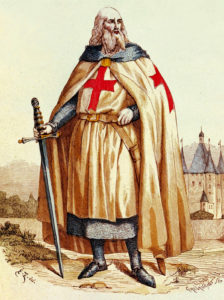
Jacques de Molay
At this time, Philip the Fair, son of St. Louis, was the king of France. When Pope Benedict XI died, Philip raised one of his groomed cardinals to the archbishop of France. The new pope moved the papacy from Rome to Avignon in France. In 1305, the new pope took the name of Clement V. He then received a letter from King Phillip to write to the master of the Temple ordering him to come immediately to conduct a new enterprise for recovery of the Holy Land. The Grand Master obliged and brought with him the treasure from Cyprus. While de Molay was in endless meetings that went no- where for the recovery plan, secret agents of the French king circulated rumors about the Templars. A pardoned prisoner was well rewarded for an accusation charging the Templars with heresy. King Philip, prepared with only these trumped up oaths, sent secret orders to all his provinces to have every Templar arrested on October 13th. An inquisition would then proceed, using torture if necessary to extract the truth of their “abominations”. The King of England, Edward the II, also received a similar letter outlining the same course of action. Edward refused to believe it. But it was begun.
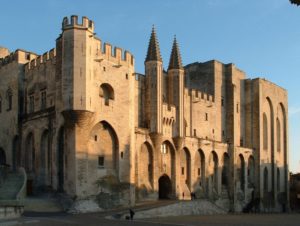
Palais du Papes in Avignon
The Knights Templar remained steadfast in their denials of all charges. Thirty-six under extreme tortures perished. The whole of Europe was astonished at the proceedings. King Edward of England wrote letters to the kings of Portugal, Castile, Aragon and Sicily, imploring them to “turn a deaf ear” to the allegations against so revered a brethren as the Knights Templar. He also wrote another letter to the Pope, imploring him to clear the Knights. The Pope replied that he had evidence that the brethren “had been secretly living in perfidious apostasy, and in detestable heretical depravity.” The king of England along with Ireland, Scotland and West and North Wales were asked to seize all lands owned by the Templars until the inquiries were completed. The Pope sent another letter listing all the various confessions extracted, though they had been done so under extreme duress. The Templars were arrested in 1308 in all parts of France and England. 229 Templar Knights were held, though some managed to escape.
On October 20th, 1309 with the Templars now imprisoned for more than a year and eight months, a tribunal convened, headed by the Pope. The papal bull was read listing 87 articles of atrocities that the Templars had performed against Jesus Christ. Thirty-three knights were brought before the tribunal for examination and all denied every charge against them. Examination upon examination continued from October through the following year. The tide was indeed turning against them. The priests condemned them, because they had always been against the church. The poor turned on them because the Templars had closed their doors to them and had only entertained the rich. The common mistrusted them, as they knew the Templars to have met secretly at night.
Some confessed near to their deaths, then when released revoked their confessions, whereby they were arrested again and condemned to the fire. Many followed; one hundred and thirteen in total were burned at the stake. The remainder, were held in solitary confinement for several more years. In London, some promised to publicly repeat a form of confession and then were solemnly absolved and reconciled to the church. “The counsels of Tarragona and Aragon pronounced the order free from heresy. In Portugal and in Germany the Templars were declared innocent.”
Jacques de Molay, the Grand master of the Temple had been in prison now for over five years. He was forced to write a confession, which afterward he called a forgery. On March of 1314, he and the Preceptor of Normandy, were brought forward with formal charges. When asked to confess his sins, de Molay replied, “I do confess my guilt, which consists in having, to my shame and dishonour suffered myself, through the pain of torture and the fear of death, to give utterance to falsehoods, imputing scandalous sins and iniquities to an illustrious order, which hath nobly served the cause of Christianity. I disdain to seek a wretched and disgraceful existence by ingrafting another lie upon the original falsehood.” At dawn the next morning, they were burned at the stake on a little island in the Seine, between the king’s garden and the convent of St Augustine.
Descending the Parisian stairs from the square du Vert Golant on the edge of where the king’s garden used to be, I saw before me the plaque that commemorates the last of the Knights Templar, Jacques de Molay. At the end of the isle de Cite now, is a peaceful little point of soil and rock where garden grass and colorful flowers bloom in plumed red and pink celosea. Here once was the swampy tulle area where Molay had been burned. When the sun came out we lounged on a park bench and meditated upon de Molay and his honor of dying by his truth. Falling from the trees were red-brown chestnuts. Their shape looking reminiscent of a human heart fallen to the ground. I sighed and could only think of the injustice that had befallen the once most beloved and devoted brethren in all of Europe. The song, Frere Jacques was going through my head and I wondered how many knew that this song was de Molay’s dirge. “Brother Jacques, brother Jacques. Are you sleeping? Are you sleeping? Morning bells are ringing, morning bells are ringing, Ding, dong, ding. ”
Though some of the Templars had escaped, and it is long rumored that they took a great deal of their treasure with them, they must have had a lonely and sad remaining existence. Could the whole of the problem been averted if King Phillip had been admitted to the Templar brotherhood? Could jealousy of the clergy have been turned into full ecclesiastical support if the Knights had simply given a portion of their wealth over in a tithe? Would they have been more beloved of the people if they had opened their hearts and pockets to the living who really needed their support and not to the memory of the son of god that was long gone? Perhaps their zealousness was an outer extension of a lie so greatly created by the church, that when it reached such abominable bloody proportions the church had no choice other than to end their power? Perhaps their very riches were too tempting for the state to leave untouched?
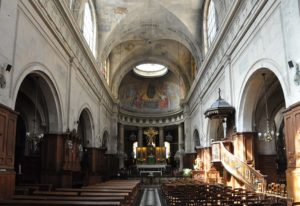
Eglise Ste-Elizabeth
“Dear God and all the forces of nature, I pray that all who have gone before and who continue to go bravely onto the following of their true wills; and having filled their hearts with the joy of their expressions of truth, and their preservation of liberty, be brought safely home. Unto their departed spirits I light this candle with love.”
Bibliography:
Addison, Charles G. The History of the Knights Templars, First published in London 1842. Reprinted by Adventures Unlimited Press Kempton, Illinois , 1997
Billings, Malcolm The Cross & The Crescent: A History of the Crusades, Sterling Publishing Co., Inc. New York, 1990
Hallam, Elizabeth-Editor Chronicles of the Crusades, Weidenfeld and Nicolson, New York, 1989
Newby, P.H. Saladin in His Time, Barnes & Noble Books, New York, 1983
Nicolle, David Saladin and the Saracens, Reed International Books, Ltd., Chicago, 1986
Partner, Peter The Knights Templar and their Myth, Destiny Books, Rochester, Vermont, 1990
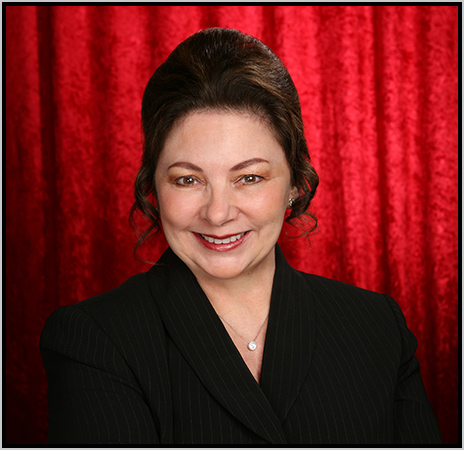 The official website of Lita-Luise Chappell, writer on sex, magic, food, distant lands, and everyday life with articles, poetry, novels, travelogues, rituals, cookbooks, and short-stories.
The official website of Lita-Luise Chappell, writer on sex, magic, food, distant lands, and everyday life with articles, poetry, novels, travelogues, rituals, cookbooks, and short-stories.
